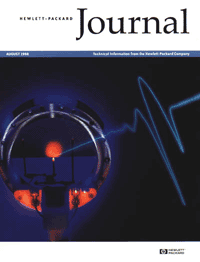|
 The heart of an ultrasound imaging system is the
electroacoustic transducer, a device that converts electrical signals into a focused mechanical wave and reconverts
reflected mechanical echoes from organs and tissue for real-time image construction. Small, calibrated transducers
called hydrophones are used to measure the acoustic output of the transducers used in these systems. The first
article in this issue describes a hydrophone developed by HP that has a spot diameter of 50 micrometers and a bandwidth
greater than 150 MHz, enabling it to characterize medical imaging transducers with operating frequencies exceeding
20 MHz.
The heart of an ultrasound imaging system is the
electroacoustic transducer, a device that converts electrical signals into a focused mechanical wave and reconverts
reflected mechanical echoes from organs and tissue for real-time image construction. Small, calibrated transducers
called hydrophones are used to measure the acoustic output of the transducers used in these systems. The first
article in this issue describes a hydrophone developed by HP that has a spot diameter of 50 micrometers and a bandwidth
greater than 150 MHz, enabling it to characterize medical imaging transducers with operating frequencies exceeding
20 MHz.
Measurement accuracy for HP optical power meters and other optical instruments is the main theme in the next article.
The article also contains an overview on the theory of measurement.
Hewlett-Packard holds several internal conferences each year to allow HP scientists and engineers to share such
things as best practices and research activities. We have five papers from the 1997 conference sponsored by engineers
from HP's integrated circuit R&D community.
Improvements in simulation and verification tools for IC design are the main topics of the first two of these articles.
The first describes the development of a high-performance equivalence checker for gate-level simulation. The next
article describes the development of a model for estimating cross talk between signal lines in submicrometer ULSI
interconnects. The model has an accuracy comparable to SPICE.
The last three articles from the conference cover reducing transmission line reflections with HP's HSTL (high-speed
transceiver logic) controlled impedance I/O pads, providing low-reflection transitions and high electrical isolation
in a low-cost RF multichip module packaging family, and testing mixed-signal ASICs with the HP 9490 mixed-signal
LSI tester.
Solutions to manufacturing and reliability problems with the epoxy resin used to attach silicon chips to substrates
are discussed in the last two articles. First, we have a description of a new casting epoxy formulation curing
condition used for HP surface mount LEDs. Second, we have an analysis that was done to determine the best way to
inhibit epoxy bleeding, which causes yield loss in ceramic pin grid array packaging.
C. L. Leath
Managing Editor
|
|